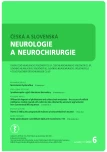Perorální kladribin v léčbě roztroušené sklerózy – data z celostátního registru ReMuS®
Authors:
D. Horáková 1
; M. Vachová 1,2; A. Tvaroh 2,3; J. Drahota 1,4; A. Mazouchová 4,5; J. Mareš 6; I. Woznicová 7; D. Zimová 8; J. Libertínová 9; A. Martinková 10; E. Recmanová 11; M. Grunermelová 12; M. Vališ 13; J. Adámková 14; R. Ampapa 15; Y. Benešová 16; M. Dufek 17; M. Peterka 13,18; E. Kubala Havrdová 1
Authors place of work:
Neurologická klinika a Centrum klinických neurověd, 1. LF UK a VFN v Praze
1; Neurologické oddělení, Krajská zdravotní a. s. – Nemocnice Teplice o. z.
2; Merck spol. s r. o., Praha
3; Nadační fond IMPULS, Praha
4; Katedra ekonomické statistiky, Vysoká škola ekonomická v Praze
5; Neurologická klinika LF UP a FN Olomouc
6; Neurologická klinika FN Ostrava
7; Neurologická klinika 3. LF UK a FN Královské Vinohrady, Praha
8; Neurologická klinika 2. LF UK FN Motol, Praha
9; Neurologická klinika Nemocnice Pardubického kraje, a. s., Pardubice
10; Neurologické oddělení Krajské nemocnice Tomáše Bati, a. s., Zlín
11; Neurologická klinika 3. LF UK a Fakultní Thomayerovy nemocnice v Krči, Praha
12; Neurologická klinika LF UK a FN Hradec Králové
13; Neurologické oddělení, Nemocnice České Budějovice, a. s.
14; Neurologické oddělení, Nemocnice Jihlava, p. o.
15; Neurologická klinika LF UK a FN Plzeň
15; Neurologická klinika LF MU a FN Brno
16; Neurologická klinika LF MU a FN u sv. Anny, Brno
17
Published in the journal:
Cesk Slov Neurol N 2021; 84(6): 555-561
Category:
Původní práce
doi:
https://doi.org/10.48095/cccsnn2021555
Summary
Aim: Our objective was to share our first clinical experience with oral cladribine gathered through the analysis of data of the national ReMuS® registry. Patients and methods: Our sample includes data of all patients who initiated oral cladribine treatment since September 1, 2018 till December 31, 2020. We also analyzed, in more detail, the subgroup of 222 patients who were assumed to complete the full cumulative dose. Our analyses included relapses, disability, employment status and financial social support, and also MRI activity in the subgroup. Data were obtained from all 15 centers for treatment of MS and analyzed in terms of descriptive statistics. Results: A total sample comprised of 436 patients, 75.5% of them females, mean age 37.0 years, and mean weight 71.9 kg. Mean duration since the disease onset was 8.4 years with a mean baseline EDSS (Expanded Disability Status Scale) score of 2.8. Mean annualized relapse rate was 1.07 prior to treatment initiation. After treatment initiation, the confirmed disability progression was not reached in 90% of patients until 20.8 (90th quantile) months after follow up. Approximately three quarters of patients stayed relapse-free in year one and two. In the defined subgroup, 85% of patients had no significant MRI activity. A switch to another disease-modifying drug was performed in 12 patients. Conclusion: In accordance with the pivotal trials, our data demonstrate a high proportion of patients without relapses, disability progression and MRI activity, and a very low proportion of patients with a treatment change.
Keywords:
Multiple sclerosis – oral cladribine – therapeutic response – patient registry
Zdroje
1. Indikační omezení úhrady LP Mavenclad. [online]. Dostupné z URL: https: //www.sukl.cz/modules/medication/detail.php?code=0222414&tab=prices.
2. Souhrn údajů o přípravku Mavenclad. [online]. Dostupné z URL: https: //www.sukl.cz/modules/medication/detail.php?code=0222414&tab=texts.
3. Giovannoni G, Cook S, Rammohan K et al. Sustained disease-activity-free status in patients with relapsing-remitting multiple sclerosis treated with cladribine tablets in the CLARITY study: a post-hoc and subgroup analysis. Lancet Neurol 2011; 10 (4): 329–337. doi: 10.1016/S1474-4422 (11) 70023-0.
4. Giovannoni G, Keller B, Jack D. Durability of NEDA status in patients with relapsing multiple sclerosis receiving cladribine tablets: CLARITY Extension [abstract]. Neurology 2019; 92 (15 Suppl): P3.2-100.
5. Giovannoni G, Leist T, Aydemir A et al. CLASSIC-MS: Long-term efficacy and real-world treatment patterns for patients receiving cladribine tablets-interim data with 8–14 years’ follow-up. [online]. Available from URL: https: //medical.emdserono.com/content/dam/web/health-care/biopharma/web/USMI/congress-presentations/Cladribine-2-Giovannoni-G-et-al-CLASSIC-MS-Long-term-Efficacy-and-Real-World-Treatment-Phase-III-Parent.pdf.
6. Meuth SG, Bayas A, Kallmann B et al. Long-term management of multiple sclerosis patients treated with cladribine tablets: an expert opinion. Expert Opin Pharmacother 2020; 21 (16): 1965–1969. doi: 10.1080/ 14656566.2020.1792885.
7. Kalincik T, Cutter G, Spelman T et al. Defining reliable disability outcomes in multiple sclerosis. Brain 2015: 138 (11): 3287–3298. doi: 10.1093/brain/awv258.
8. Giovannoni G, Comi G, Cook S et al. A placebo-controlled trial of oral cladribine for relapsing multiple sclerosis. N Engl J Med 2010; 362 (5): 416–426. doi: 10.1056/NEJMoa0902533.
9. Sørensen PS, Centonze D, Giovannoni G et al. Expert opinion on the use of cladribine tablets in clinical practice. Ther Adv Neurol Disord 2020; 13: 1–17. doi: 10.1177/1756286420935019.
10. Ampapa R, Dufek M, Hradílek P et al. Léčba roztroušené sklerózy perorálním kladribinem. Neurol Praxi 2021; 22 (3): 178–182.
11. Zapletalová O, Krejsek J. Roztroušená skleróza mozkomíšní, těhotenství, mateřství a kojení. Cesk Slov Neurol N 2019; 82/115 (2): 161–165. doi: 10.14735/am csnn2019161.
12. Stastna D, Menkyova I, Drahota J et al. Multiple sclerosis, neuromyelitis optica spectrum disorder and COVID-19: a pandemic year in Czechia. Mult Scler Relat Disord 2021; 54: 103104. doi: 10.1016/j.msard.2021.103 104.
13. Achiron A, Mandel M, Dreyer-Alster S et al. Humoral immune response to COVID-19 mRNA vaccine in patients with multiple sclerosis treated with high-efficacy disease-modifying therapies. Ther Adv Neurol Disord 2021; 14: 17562864211012835. doi: 10.1177/17562864211012 835.
Štítky
Dětská neurologie Neurochirurgie NeurologieČlánek vyšel v časopise
Česká a slovenská neurologie a neurochirurgie

2021 Číslo 6
Nejčtenější v tomto čísle
- Stiff -person syndrom
- Normotenzní hydrocefalus
- Synukleinopatie a jejich laboratorní biomarkery
- Perorální kladribin v léčbě roztroušené sklerózy – data z celostátního registru ReMuS®
